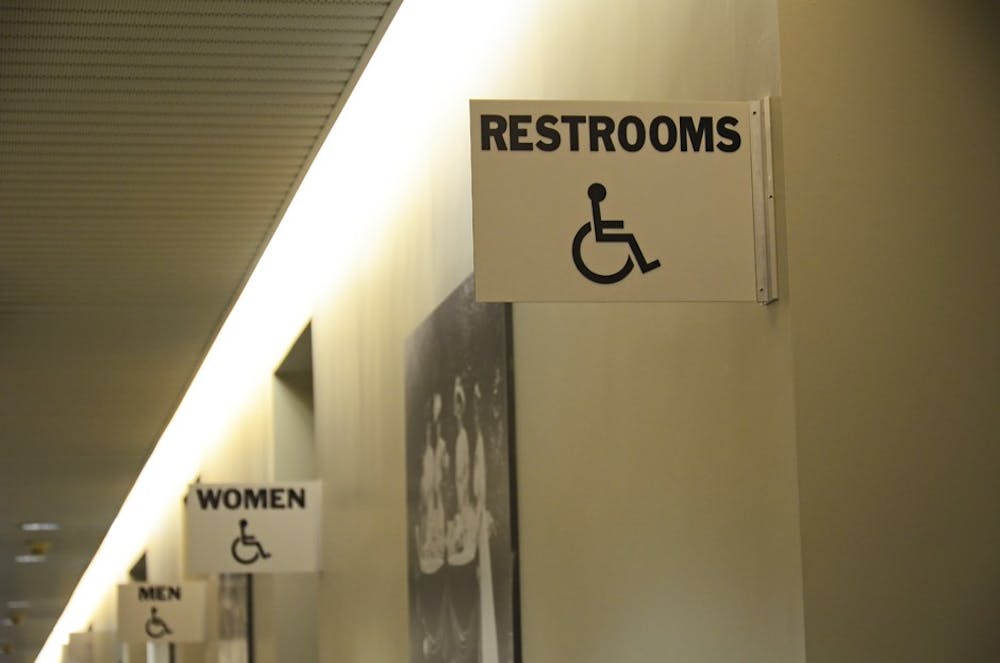More than a year has passed since the Office of the University Architect announced its intention to launch a feasibility study to explore the possibility of expanding the number of all-gender bathrooms on campus.
Now, the OUA has finished the study, said David Hollenberg, who served as the University Architect for nearly 12 years until his partial retirement in June. The next steps in the expansion involve a partnership between Penn Facilities and Real Estate Services and the University's schools to reconstruct existing bathrooms, officials said.
In June 2017 the LGBT Center, under the leadership of Director Erin Cross, partnered with FRES to increase the number of all-gender bathrooms on campus, determining that more than 100 single-stall restrooms could be converted to serve all genders.

Last June, 37 of the approximately 200 nonresidential buildings maintained by FRES included at least one all-gender bathroom. As of this August, Cross and Hollenberg said the number has increased to 55. Hollenberg said, however, this statistic is slightly misleading as it includes property-type buildings, like garages, Greek houses, and utilities, in its total. Of the 129 non-property nonresidential buildings on campus, he said roughly 42 percent have at least one all-gender bathroom.
Funded by the OUA, the months-long feasibility studies were used to determine which academic, recreational, and administrative buildings on campus could accomodate all-gender bathrooms.
“UPenn was trying to look at a number of single-sex single-stall bathrooms and what it would take to make them multi, all-gender from an engineering standpoint specifically,” Hollenberg said. “We’ve demonstrated it’s possible and feasible and we showed how.”
Hollenberg explained that members of his office spent the time completing conceptual designs for specific buildings and academic departments that had expressed interest in the project. He added that they also developed a standard system or “language” to make the new bathrooms more easily replicated in future buildings. The OUA will post the standard dimensions and designs for all-gender bathrooms on its website later this academic year, he said.
RELATED:
Harvard is planning to expand its gender-neutral housing program to first-year students
How Penn's goals of installing more gender-neutral bathrooms have panned out since the fall
According to Cross, the OUA's work on the study means that Penn now has access to a template for the projects.
"[The schools] just have to pay for construction work and the specific design for their school. I can’t stress how important this is,” Cross said.
Heidi Wunder, a FRES spokesperson, wrote in an email that the OUA, which is a department of FRES, will continue working with the schools engaged in the ongoing pilot program.
She added that future bathroom renovations, like all on-campus construction, would be undertaken as a partnership between FRES and schools/buildings which choose to install all-gender bathrooms.
Queer Student Alliance Chair and College junior Amber Auslander, who uses they/them pronouns, said they “understand the difficulties” of creating more all-gender bathrooms, especially since converting bathrooms could incite pushback from some students.
“It’s a lot of student efficacy that leads to these changes rather than the administration reaching out to us and wanting to make their students more comfortable. The situation should be considered more pressing,” Auslander said. “I do think more of an effort needs to be made to show the Penn trans communities that they are cared about and their voices are being heard.”
Some students noted that many existing all-gender bathrooms are not easily available and some are not even accessible. For example, in June, a flyer criticizing the lack of women's and all-gender bathrooms was taped to a bathroom door in David Rittenhouse Laboratories.

“A lot of the gender neutral bathrooms are kind of out of the way, for some reason. I find that —and this goes even more for a conversation about disability activism and rights — but a lot of them are out of the way, high up, you need to climb the stairs to reach them,” Auslander said.
College junior Brennan Burns, a transgender woman who feels most comfortable using all-gender bathrooms, recounted many instances of having to go out of her way to access a bathroom. During a class that she had on the top floor of Claudia Cohen Hall, she had to travel to a bathroom in the basement. In Charles Addams Fine Arts Hall, she said, the only all-gender bathroom is on the third floor.
“I will be fair, Penn is a much better and friendlier campus than most college campuses, but there isn’t any reason we shouldn’t try to be better and gender neutral bathrooms would improve that greatly,” Burns said. “It’s a frustrating part for a vulnerable population that the administration would rather have new construction rather than meet our needs."
Cross said the project is pushed “as far as it can go for the moment,” although she believes the creation of all-gender bathrooms will quickly snowball across campus.
“As soon as the first few [bathrooms] go, everyone will want to do it, and we’ll start converting bathrooms right and left,” she said.









